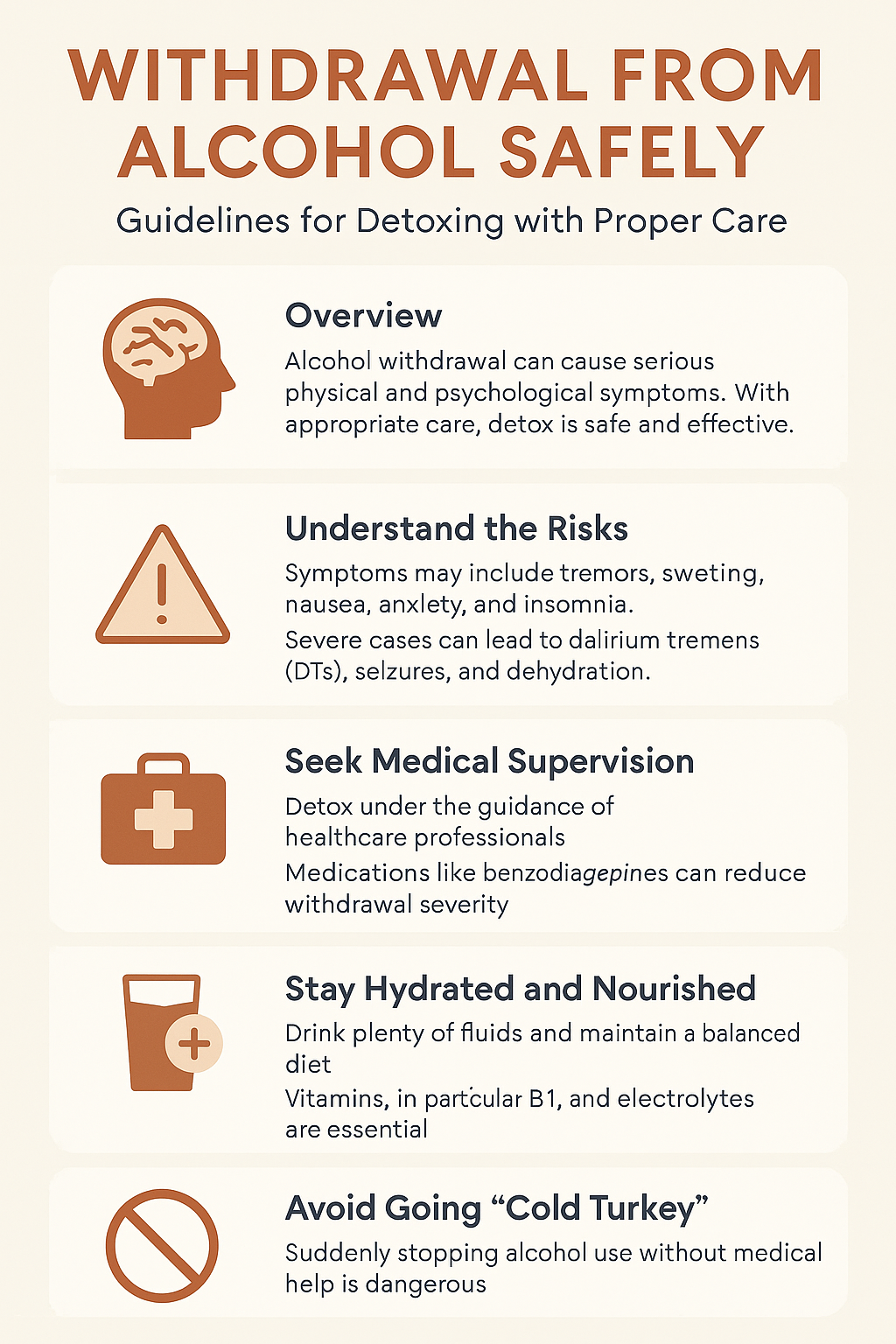
Alcohol withdrawal impacts both body and mind. This guide offers tips for safely managing the challenges of cutting back or quitting alcohol.
Many people decide to withdraw from alcohol for various reasons, from health concerns to personal goals. However, the process is not as simple as just stopping drinking overnight. It requires careful planning, support, and sometimes professional help. Take the time to map out your plan and assess every detail for a smooth transition.
In this guide, you will learn practical steps for safely withdrawing from alcohol while minimizing risks and discomfort. You can navigate this challenge effectively with a clear plan, informed choices, and a supportive environment. We have provided extra explanations throughout the guide to help you better understand each stage of this process.
Step 1: Understand Your Withdrawal Journey
Before starting the process of reducing or stopping alcohol consumption, it is essential to understand what withdrawal means for your body. Alcohol affects various systems in your body, and sudden changes may lead to symptoms such as shaking, anxiety, or even more serious health issues. Taking the time to understand how your body might react can help you prepare both physically and mentally.
Take some time to reflect on your current habits and consider keeping a personal log of how you feel at different times of the day. This record can be a reference when you notice changes in your body’s responses. Additionally, researching potential complications and understanding the timeline of common withdrawal symptoms can provide a more comprehensive picture of what lies ahead.
Questions to Consider:
- How much alcohol am I currently consuming?
- What changes have I noticed in my physical or emotional state?
- Are there underlying health concerns that might complicate withdrawal?
- What support systems do I have, such as friends, family, or counselors?
Example Considerations for Your Journey:
- Recognize that withdrawal symptoms can vary in intensity and duration.
- Understand that your body needs time to adjust to a new routine without alcohol.
- Assess your mental readiness to embrace significant lifestyle changes.
- Know that proper planning can help reduce physical discomfort and emotional stress.
Clarity on your current state and what you hope to achieve helps shape a withdrawal plan that is safe and manageable. It also provides a roadmap to refer back to during challenging moments. Checking in with yourself thoroughly is a critical first step toward making sound decisions.
Step 2: Consult a Health Professional
Withdrawal from alcohol can have significant physical implications. Discussing your plans with a doctor or addiction specialist who has a thorough understanding of this process is highly recommended. Professional guidance can help you set realistic expectations and design a personalized plan that minimizes risks.
How to Work with a Professional:
- Schedule a complete evaluation to discuss your drinking pattern and overall health.
- Discuss potential withdrawal symptoms and what you can expect.
- Plan a gradual reduction schedule that fits your specific health needs.
Practical Advice:
Your doctor may suggest a medically supervised detox, especially if your alcohol consumption has been heavy. This ensures that any severe symptoms, such as seizures or severe dehydration, are managed appropriately with professional oversight. In many cases, having a scheduled follow-up appointment can also provide you with extra reassurance as you progress through the withdrawal process.
Consulting a specialist provides expert advice and establishes a safety net that can make all the difference during challenging times. Remember, asking for help shows strength and dedication to your well-being.
Step 3: Tapering Off Gradually
Instead of quitting alcohol abruptly, a gradual reduction—often called tapering off—can help reduce withdrawal symptoms. Tapering means slowly decreasing your alcohol intake over days or weeks in a controlled manner. This method allows your body more time to adjust to lower levels of alcohol and can make the transition much smoother.
Methods for Tapering:
- Keep a daily journal to record your alcohol intake and corresponding physical responses.
- Slowly reduce the quantity of alcohol you consume each day or week.
- Select specific days to cut down your consumption and track steady progress.
Real-Life Example:
You might start by setting a limit that is 10-20% lower than your usual amount. Once your body adjusts, reduce further until you eventually stop altogether. Documenting your progress in a journal not only helps you monitor your improvements but also allows you to look back and see how far you’ve come. This reflective practice can boost your confidence and motivate you during more challenging phases.
Additionally, consider using supportive techniques, such as setting reminders or involving a friend in your progress checks. These extra measures can prove crucial in maintaining your commitment to the tapering schedule while monitoring your overall well-being.
Step 4: Manage Withdrawal Symptoms Safely
Withdrawal symptoms are common and can include irritability, nausea, and restlessness. Depending on their level of consumption, some individuals might experience mild symptoms, while others face more moderate or even severe reactions. Understanding these symptoms can help you respond appropriately when they occur.
How to Alleviate Symptoms:
- Stay well-hydrated—water and electrolyte solutions are essential and can make a big difference.
- Eat balanced meals to help your body recover from the stress of withdrawal.
- Consider taking supplements only under the guidance of a healthcare professional.
Additional Support Tips:
If you experience anxiety or difficulty sleeping, relaxation techniques such as deep breathing exercises or meditation might help significantly. Some people find that joining a support group creates a community of individuals facing similar challenges. The more prepared you are to manage these symptoms, the more confident you will feel in your recovery process.
Having a pre-planned strategy for moments when symptoms intensify can be beneficial. This eases immediate discomfort and builds long-term resilience as you gain a better understanding of your body’s signals.
Step 5: Establish a Supportive Environment
Changing your surroundings to reduce potential triggers is a smart strategy. An environment that promotes recovery can help balance withdrawal symptoms and boost overall well-being. Creating a space that is free of alcohol cues is key to maintaining focus on your goals.
Strategies to Create a Supportive Space:
- Inform close family or friends about your plan so they can offer assistance during your journey.
- Remove alcohol from your home and replace it with healthier alternatives.
- Plan regular check-ins with someone who understands what you’re going through.
- Create a calm and relaxing area to unwind while practicing self-care.
This is not only about having a clean physical space. It is equally important to cultivate an atmosphere of understanding and hope. Small changes in your environment can significantly shift your overall recovery experience.
Adding extra touches such as soft lighting, comfortable seating, or even calming music can make your space more inviting and conducive to relaxation. Such adjustments soothe your mind and help keep you on track with your recovery plan.
Step 6: Self-Care and Aftercare Planning
Following a safe withdrawal, self-care and aftercare are essential. These practices help you remain focused on your recovery and prevent a relapse into old habits. A structured aftercare plan enables you to maintain progress and build on the gains made during detox.
Aftercare Strategies:
- Establish a routine incorporating exercise, proper sleep, and nutritious meals.
- Explore new hobbies or activities that keep you interested and positive.
- Consider counseling or therapy sessions to understand the root causes of your drinking habits.
- Join an alcohol recovery community for mutual support and shared experiences.
Example of a Self-Care Routine:
After successfully moving through withdrawal, you can begin a new daily routine. Start your day with a healthy breakfast, followed by light exercise to wake up your body. Dedicate some time mid-day for a reflective walk or a hobby you enjoy, and conclude the day with a period of relaxation, perhaps reading or listening to calm music. These habits can help fill the gap once occupied by alcohol use while building a sustainable, healthy lifestyle.
Consider scheduling regular follow-up appointments with a healthcare provider to monitor your progress. Continuous care and reassessment ensure that any emerging challenges are met promptly and that your recovery remains on track. Over time, these self-care practices will blend to form an all-in-one support system for your new way of living.
Step 7: Stay Consistent and Adapt to Changes
Withdrawal and recovery require ongoing commitment. There will be days when progress seems slow and setbacks occur. The key is to keep moving forward and adjust your strategies as needed. Consistency is key to establishing habits that support a long-term alcohol-free lifestyle.
Tips for Maintaining Consistency:
- Keep a detailed daily log of your progress, noting successes and setbacks.
- Set realistic short-term goals that can be adjusted if circumstances change.
- Accept that occasional setbacks are part of the process and do not indicate failure.
- Use any setbacks as learning opportunities to fine-tune your approach.
Building a routine that supports recovery is like constructing a solid foundation. With each small step, you reinforce the structure of your new lifestyle. Over time, this consistency sustains your progress, building self-confidence and resilience against future challenges.
Common Questions & Troubleshooting
What if my withdrawal symptoms become severe?
If symptoms escalate to severe levels, such as hallucinations or extreme confusion, it is critical to seek immediate medical help. A health professional can ensure that you remain safe and make necessary adjustments to your treatment plan.
How can I prevent a relapse during withdrawal?
- Stay accountable with regular check-ups with your healthcare provider or counselor.
- Build a strong support network with friends and family who genuinely understand your goals.
- Keep engaged in activities that lift your mood and provide a sense of purpose and distraction.
What should I do if I feel overwhelmed?
Feeling overwhelmed is common during recovery. Take a break and use relaxation techniques, such as deep breathing exercises or meditation, to center yourself in such moments. Avoid harsh self-criticism and reach out to someone who can listen and guide you through these challenging times.
Final Thoughts & Next Steps
With the right approach and support, safely withdrawing from alcohol is an achievable goal. By understanding your journey and gradually reducing your alcohol intake, you give both your body and mind the time they need to adjust. Remember that each process step is unique, and there isn’t a one-size-fits-all solution. Your experience will be personal, and adjustments are entirely routine.
Take a moment to reflect on everything you have learned from this guide. It might help to write down what strategies feel most manageable and what support systems are already in place. Planning and setting achievable targets will increase your odds of long-term success in your recovery adventure.
Your Action Plan:
- Start by clearly outlining your current alcohol use and discussing your withdrawal plan with a trusted health professional.
- Design a tapering schedule that gradually decreases your intake, rather than stopping abruptly.
- Prepare your environment by removing alcohol and setting up a dedicated space for self-care and relaxation.
- Implement strategies to manage withdrawal symptoms while prioritizing simple routines that support self-care.
- Establish a robust support network, including friends, family, or community groups, to lean on during recovery.
What small step will you take today toward a healthier lifestyle? Your journey to recovery begins with one action. Take the time to reflect on the guidance provided, plan your next moves carefully, and remember that every step forward matters. Your future is built step by step, and each favorable decision paves the way for a life free from alcohol.
As you wrap up this guide, remember that recovery is an ongoing process. Maintaining a proactive attitude, staying connected with loved ones, and adjusting your plan as necessary will help you sustain your progress. Keep your eyes on your goals, and let each day remind you of your strength to redefine your lifestyle.
Video: What Happens When You STOP DRINKING Suddenly?
